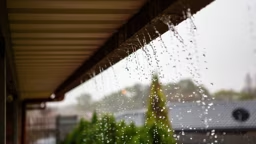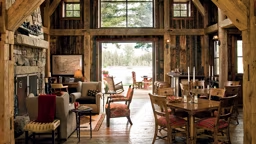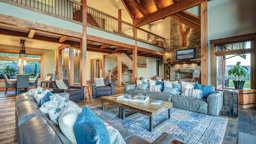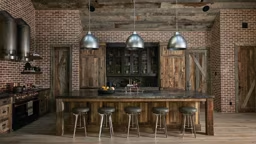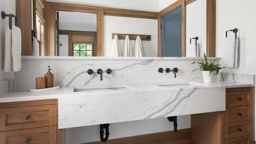
When you’re building a traditional log cabin (i.e., a basic log shell on the outside) or a timber-framed cottage, it’s easy to only consider the conventional materials that go into a house — items like 2-by-10 or 2-by-12 rafter systems, fiberglass insulation in the roof and hardwood or ceramic-tile flooring.
But what a lot of future log or timber frame homeowners don’t take into consideration is that you can incorporate modern — even innovative — materials into construction and still stay true to the structure’s historic roots, all while increasing the value and comfort of your home. From building components to finishing products, consider these modern materials for your classic cabin.
High Velocity HVAC.
A standard HVAC system takes up a lot of space – both in terms of the unit and the ductwork required to get the conditioned air to your rooms. Opting for a high-velocity HVAC is a game changer.
“A high velocity HVAC is one-third the size of a conventional system, as is the flexible tubing — traditional bulky ducts are eliminated,” says Scott Intagliata, co-owner of Unico, a leading manufacturer of these systems. “It can fit anywhere.”
So, in homes where mechanicals have to fit into compact or difficult spaces — or in log and timber houses where hiding ducts can be challenging — coupled with their exceptional performance (they have a leak rate of less than 3 percent compared to 20 to 30 percent for a standard forced-air unit) and their super-quiet operation, high velocity HVACs just make sense. As Scott says, “Our system fits your design — you don’t have to design your home to fit our system.”
Learn more: unicosystem.com
Insulation.
Structural insulated panels (SIPs) aren’t “new.” They’ve been nearly synonymous with timber frame construction for decades, thanks to the way the solid-core panels wrap the frame in a continuous envelope of superior insulating protection. But SIPs aren’t just for timber homes. A modern log home can benefit from their high R-values as well, namely in the roof structure.
In addition to SIPs, spray foam insulation (such as BASF’s Enertite and Spraytite) has become more prevalent than fiberglass batts in log homes, because it offers a more complete sealant against air infiltration. Many log and timber home buyers don’t realize this product an option for them, but it’s perfect for sealing cavities in this type of construction. It’s a bit more expensive upfront, but it performs much better than fiberglass and gives a home’s energy-efficiency a big boost over batts, which will actually save you money over the life of the home.
Learn more: sips.org; spf.basf.com/enertite.php
Siding, Soffit & Facia.
Even in a glorious wood home, to preserve vulnerable areas and minimize long-term maintenance sometimes a little synthetic technology is in order. Enter fiber-cement materials.
On a timber home, you may decide to clad the entire exterior in fiber-cement siding, but even on a full-log house, this material has applications, namely hard-to-maintain gable ends and soffit and facia — even garages. In addition to its easy upkeep, fiber cement is non-combustible; moisture, rot and insect resistant; and won’t warp or melt like vinyl can. Big bonus: Manufacturers like JamesHardie and Nichiha offer options that mimic wood so closely, you’re hard pressed to tell it from the real thing. And, if you want to interject a little color, it’s easily painted.
Learn more: nichiha.com; jameshardie.com
Decking.
Like SIPs, composite decking is not a new product. Homeowners have been building outdoor decks with it for years. But what is new are the strides manufacturers have made in its appearance, allowing even the most steadfast natural-wood lovers to consider it as a legitimate contender.
Composite decking is a blend of wood fibers and plastic. Though it’s enjoyed a reputation for being durable, it’s been criticized for looking artificial — a drawback that has kept log and timber home buyers from choosing it. It just didn’t feel compatible with the objective to live in a wood home.
But manufacturers have resolved its prior pitfalls, like unrealistic wood grain, fading and warping. It’s more durable — and more natural looking — than ever. Add that to the fact that it doesn’t splinter or rot like pressure-treated wood can, the way it stands up to rain and snow and its longevity, composite decking makes a whole lot of sense. And thanks to new companies entering the marketplace (Trex used to have close to monopoly on the material), the upfront cost is coming down.
Still have your heart set on wood decking for your log or timber outdoor spaces? For durability and low-maintenance, look to exotic species like ipe, ironwood or garapa instead of pressure-treated lumber.
Learn more: Composite: trex.com; calibamboo.com/composite-decking.html; timbertech.com
Exotic woods: advantagelumber.com
Flooring.
Ahhh, ubiquitous hardwood … it’s a log and timber home staple. But real hardwoods are pricey, and they’re not the only game in town.
Luxury vinyl plank (LVP) is a durable, affordable flooring alternative on the rise. Where once it tended to look fake, now it realistically mimics hardwoods without the scratches, dings or susceptibility to moisture.
When it comes to tile, large-format porcelain has taken over the market. It’s affordable, extremely durable and very attractive. It even can clone the look of wood or marble. And, of course, its use isn’t limited to floors. Showers, kitchen backsplashes and fireplace surrounds are all ideal applications, too.
Learn more: LVP: shawfloors.com; mohawkflooring.com Porcelain tile: daltile.com; crossvilleinc.com
Lighting.
Energy-efficient LED lighting has become a residential mainstay. And we’re not just talking switching your lamps from incandescent bulbs to LEDs. With LED panels, you can place lighting in more places, including recessed lighting. Before, recessed can-lights were bulky, requiring you create a cavity 6 to 8 inches deep into your ceiling per light and interfering with your insulation. Recessed LED puck lights are flat, requiring cuts only ¼- to ½-inch deep to mount, which keeps the integrity of your insulation intact. Plus, because the cost is less, it allows you to install more units, giving you more broadcast illumination. They even can change colors for a festive mood.
Learn more: philips-hue.com/en-us/products/smart-recessed-lights
Keep It Clean
Technology can make daily living easier and healthier. Check out four of our favorite smart-home solutions:
1. Smart-home system faucets (kohler.com). Not only are they cool and conveniently hands-free, they reduce the transference of germs and bacteria — a pretty big deal these days.
2. WiFi-enabled and voice-activated shower systems (moen.com/smart-home/smart-shower). Control the water temperature and even play music while you bathe – all with an app or the sound of your voice.
3. Antimicrobial coatings (microban.com/antiviral/technologies). Though they seem smooth, stone or quartz counters and even glass have small pits that can collect bacteria. These coatings seal those microscopic crannies, removing the spaces for viral or bacterial growth and keeping your surfaces sanitary for years.
4. Central vacuum systems (broan-nutone.com/en-us/central-vacuum-systems). Better at evacuating dust, pollen and other allergens than typical vacuum cleaners, whole-house central vacuums let you get a deeper clean. And modern models allow you to hide the hoses within the wall – no more lugging the awkward vacuum around.




